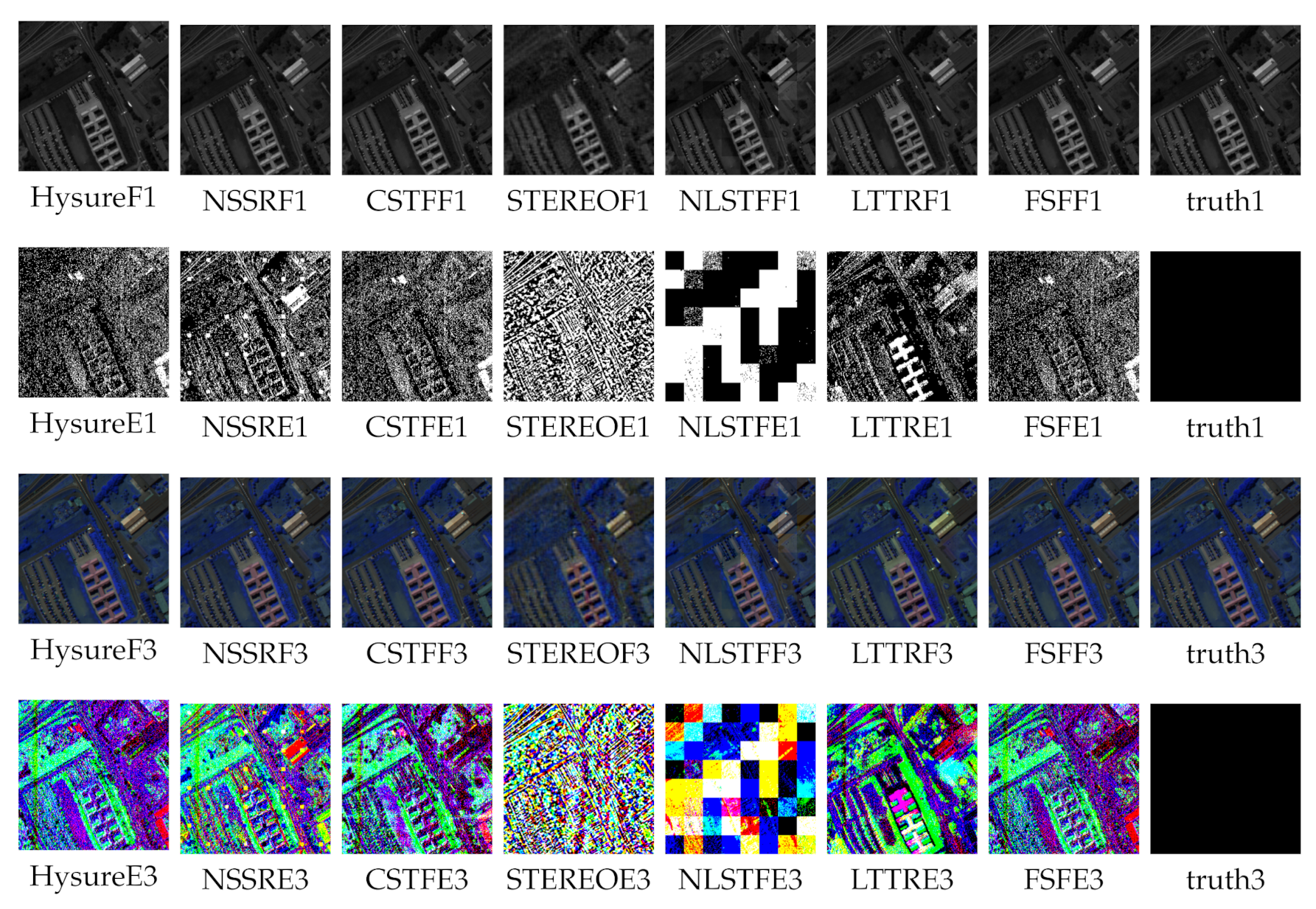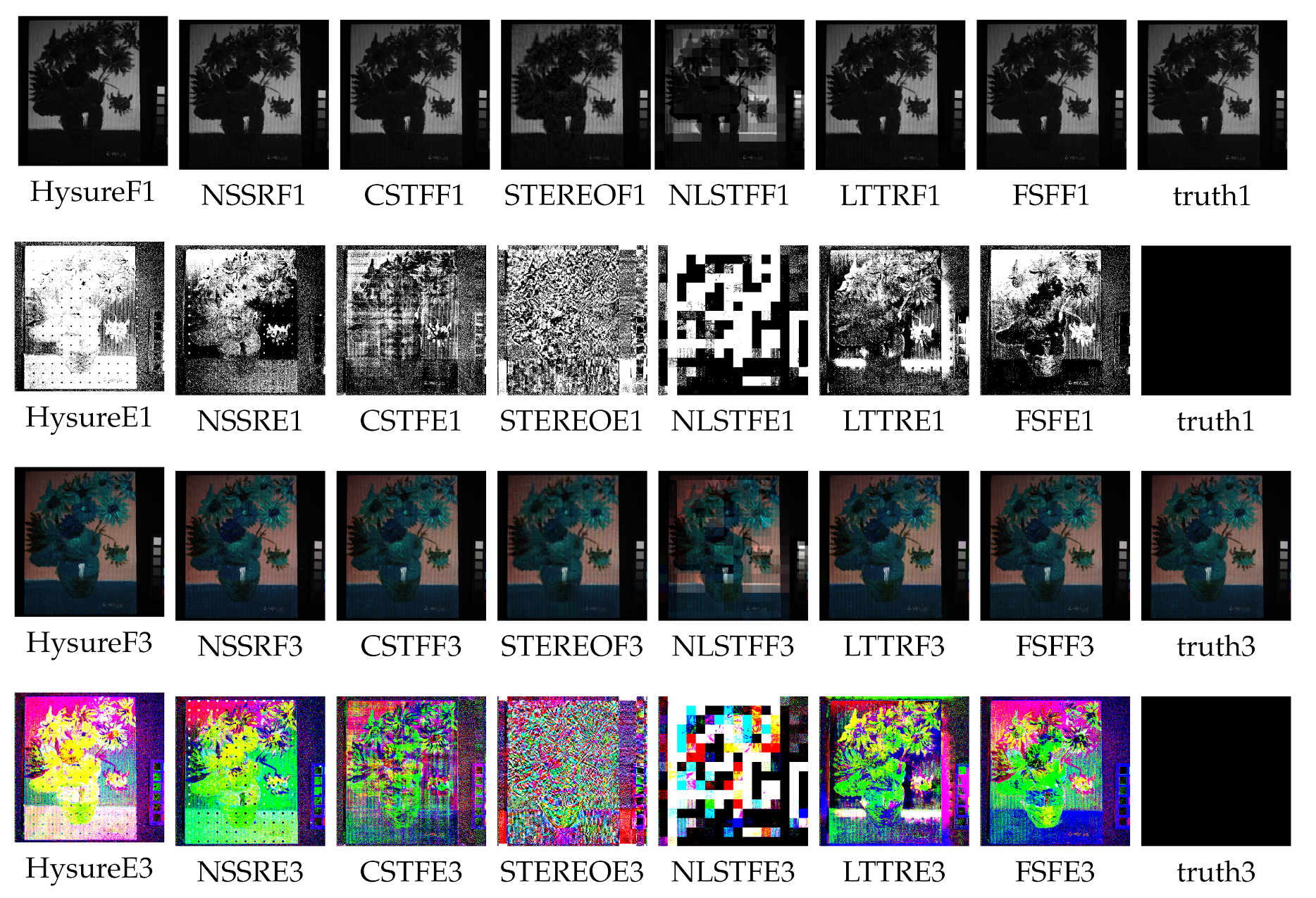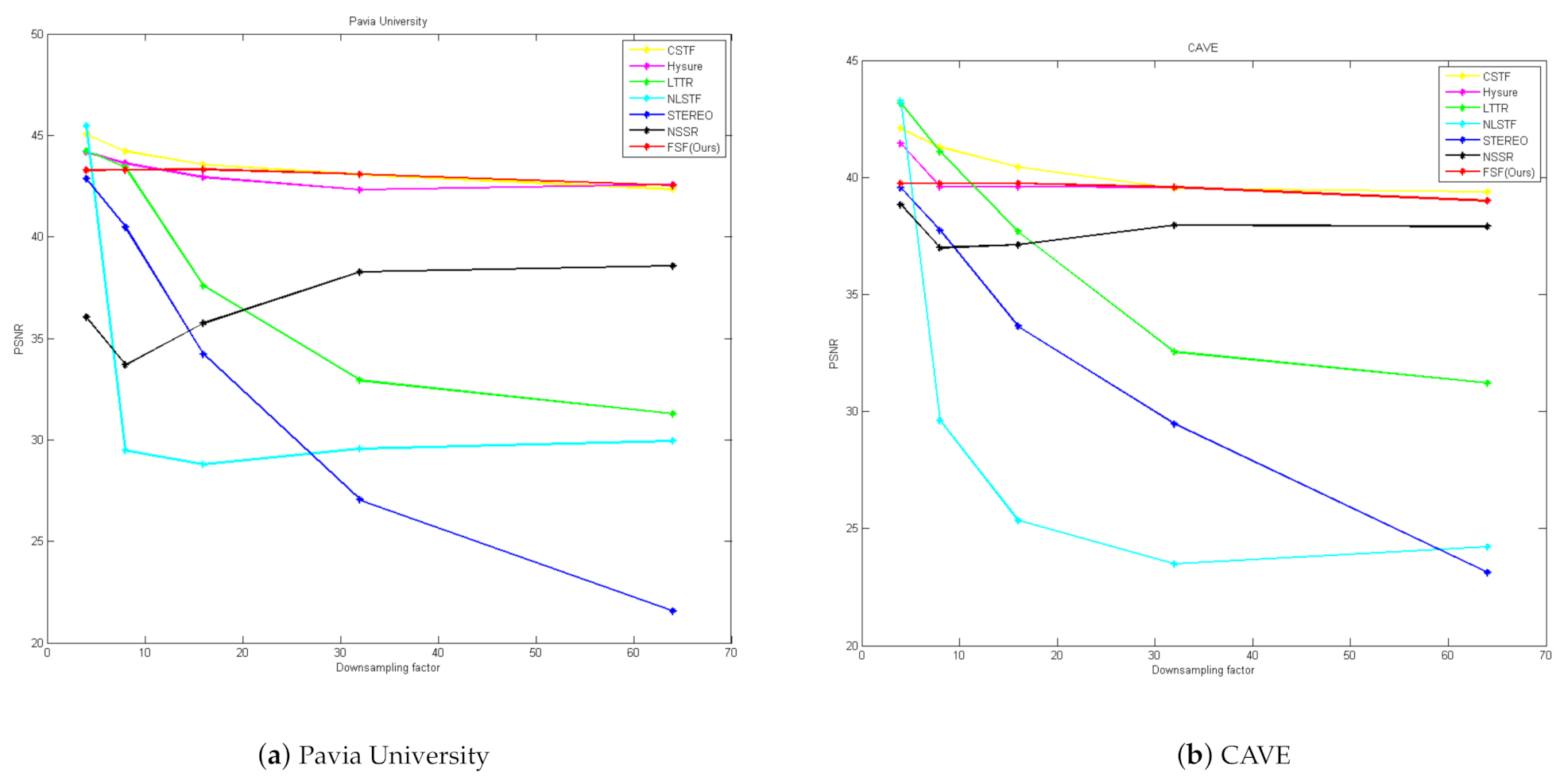Fast and Stable Hyperspectral Multispectral Image Fusion Technique Using Moore–Penrose Inverse Solver
Abstract
:1. Introduction
- It is the first time that the Moore–Penrose inverse has been used to determine the solution of the spectral coefficient matrix, which simplifies the solution process of the fusion model, dramatically reduces the computational workload, and shortens the fusion time.
- A multiplicative iterative optimization process is used to optimize the spectral basis and coefficient matrices, enabling further enhancement of the fused results and improving the quality of the fusion.
- Previous fusion methods stop optimizing the fusion results after obtaining the spectral basis and coefficient matrices. In contrast, the method proposed in this paper continues to optimize the rough HR-HSI estimates after fusion to further improve the fusion quality after obtaining the spectral basis and coefficient matrices.
2. Proposed Method
2.1. Fusion Model
2.2. Moore–Penrose Inverse
| Algorithm 1 Moore–Penrose inverse |
| Require: for k = 1:K do if then end if end for for k = 1:K do end for return |
2.3. Optimized Fusion Solution
| Algorithm 2 FSF Algorithm |
| Require: Get by Equations (6) and (7) Get by Algorithm 2 for k = 1:K do Update by Equation (12) end for for k = 1:K do Update by Equation (16) end for return |
3. Experiments
3.1. Date Set
3.2. Compared Methods
3.3. Quantitative Metrics
3.4. Parameters Discussion
3.5. Experimental Setting
4. Results and Analysis
4.1. Timeliness of The FSF
4.2. Stability of The FSF
5. Conclusions
Author Contributions
Funding
Conflicts of Interest
Sample Availability
References
- Samiappan, S. Spectral Band Selection for Ensemble Classification of Hyperspectral Images with Applications to Agriculture and Food Safety; Mississippi State University: Starkwell, MS, USA, 2014. [Google Scholar]
- Liu, Z.; Yan, J.Q.; Zhang, D.; Li, Q.L. Automated tongue segmentation in hyperspectral images for medicine. Appl. Opt. 2007, 46, 8328–8334. [Google Scholar] [CrossRef] [Green Version]
- Pechanec, V.; Mráz, A.; Rozkošný, L.; Vyvlečka, P. Usage of Airborne Hyperspectral Imaging Data for Identifying Spatial Variability of Soil Nitrogen Content. ISPRS Int. J. Geoinf. 2021, 10, 355. [Google Scholar] [CrossRef]
- Meer, F.D.V.D.; Werff, H.M.A.V.D.; Ruitenbeek, F.J.A.V.; Hecker, C.A.; Bakker, W.H.; Noomen, M.F.; Meijde, M.V.D.; Carranza, E.J.M.; Smeth, J.B.D.; Woldai, T. Multi- and hyperspectral geologic remote sensing: A review. Int. J. Appl. Earth Obs. Geoinf. 2012, 14, 112–128. [Google Scholar] [CrossRef]
- Cui, Y.; Zhang, B.; Yang, W.; Yi, X.; Tang, Y. Deep CNN-based Visual Target Tracking System Relying on Monocular Image Sensing. In Proceedings of the 2018 International Joint Conference on Neural Networks (IJCNN), Rio de Janeiro, Brazil, 8–13 July 2018. [Google Scholar]
- Cui, Y.; Zhang, B.; Yang, W.; Wang, Z.; Li, Y.; Yi, X.; Tang, Y. End-to-End Visual Target Tracking in Multi-robot Systems Based on Deep Convolutional Neural Network. In Proceedings of the IEEE International Conference on Computer Vision Workshops, Venice, Italy, 22–29 October 2017; pp. 1113–1121. [Google Scholar]
- Irani, M.; Anandan, P. Robust Multi-Sensor Image Alignment. In Proceedings of the Sixth International Conference on Computer Vision, Bombay, India, 7 January 1998. [Google Scholar]
- Carper, W.J.; Lillesand, T.M.; Kiefer, P.W. The use of intensity-hue-saturation transformations for merging SPOT panchromatic and multispectral image data. Photogramm. Eng. Remote Sens. 1990, 56, 459–467. [Google Scholar]
- Shah, V.P.; Younan, N.H.; King, R.L. An Efficient Pan-Sharpening Method via a Combined Adaptive PCA Approach and Contourlets. IEEE Trans. Geosci. Remote Sens. 2008, 46, 1323–1335. [Google Scholar] [CrossRef]
- Cheng, J.; Zhang, H.; Shen, H.; Zhang, L. A Practical Compressed Sensing-Based Pan-Sharpening Method. IEEE Geosci. Remote Sens. Lett. 2012, 9, 629–633. [Google Scholar] [CrossRef]
- Zhang, Y.; Backer, S.D.; Scheunders, P. Noise-Resistant Wavelet-Based Bayesian Fusion of Multispectral and Hyperspectral Images. IEEE Trans. Geosci. Remote Sens. 2009, 47, 3834–3843. [Google Scholar] [CrossRef]
- Wei, Q.; Bioucas-Dias, J.; Dobigeon, N.; Tourneret, J.Y. Hyperspectral and Multispectral Image Fusion based on a Sparse Representation. IEEE Trans. Geosci. Remote Sens. 2015, 53, 3658–3668. [Google Scholar] [CrossRef] [Green Version]
- Simoes, M.; Bioucas-Dias, J.; Almeida, L.B.; Chanussot, J. A Convex Formulation for Hyperspectral Image Superresolution via Subspace-Based Regularization. IEEE Trans. Geosci. Remote Sens. 2015, 53, 3373–3388. [Google Scholar] [CrossRef] [Green Version]
- Hardie, R.C..; Russell, C.; Eismann, M.T.; Michael, T.; Wilson, G.L.; Gregory, L. MAP Estimation for Hyperspectral Image Resolution Enhancement Using an Auxiliary Sensor. IEEE Trans. Image Process. 2004, 13, 1174–1184. [Google Scholar] [CrossRef] [PubMed]
- Eismann, M.T. Resolution Enhancement of Hyperspectral Imagery Using Maximum a Posteriori Estimation with a Stochastic Mixing Model. Ph.D. Thesis, University of Dayton, Dayton, OH, USA, 2004. [Google Scholar]
- Iordache, M.D.; Bioucas-Dias, J.M.; Plaza, A. Sparse Unmixing of Hyperspectral Data. IEEE Trans. Geosci. Remote Sens. 2011, 49, 2014–2039. [Google Scholar] [CrossRef] [Green Version]
- Zhukov, B.; Oertel, D.; Lanzl, F.; Reinhackel, G. Unmixing-based multisensor multiresolution image fusion. IEEE Trans. Geosci. Remote Sens. 1999, 37, 1212–1226. [Google Scholar] [CrossRef]
- Minghelli-Roman, A.; Polidori, L.; Mathieu-Blanc, S.; Loubersac, L.; Auneau, F.C. Spatial resolution improvement by merging MERIS-ETM images for coastal water monitoring. IEEE Geosci. Remote Sens. Lett. 2006, 3, 227–231. [Google Scholar] [CrossRef]
- Grohnfeldt, C.; Bamler, R. Jointly Sparse Fusion of Hyperspectral and Multispectral Imagery. In Proceedings of the 2013 IEEE International Geoscience and Remote Sensing Symposium—IGARSS, Melbourne, VIC, Australia, 21–26 July 2013. [Google Scholar]
- Dong, W.; Fu, F.; Shi, G.; Cao, X.; Wu, J.; Li, G.; Li, X. Hyperspectral Image Super-Resolution via Non-Negative Structured Sparse Representation. IEEE Trans. Image Process. 2016, 25, 2337–2352. [Google Scholar] [CrossRef]
- Yokoya, N.; Member, S.; Yairi, T.; Iwasaki, A. Coupled Nonnegative Matrix Factorization Unmixing for Hyperspectral and Multispectral Data Fusion. IEEE Trans. Geosci. Remote Sens. 2012, 50, 528–537. [Google Scholar] [CrossRef]
- Dian, R.; Li, S. Hyperspectral Image Super-Resolution via Subspace-Based Low Tensor Multi-Rank Regularization. IEEE Trans. Image Process. 2019, 28, 5135–5146. [Google Scholar] [CrossRef] [PubMed]
- Long, J.; Peng, Y.; Li, J.; Zhang, L.; Xu, Y. Hyperspectral Image Super-resolution via Subspace-based Fast Low Tensor Multi-Rank Regularization. Infrared Phys. Technol. 2021, 116, 103631. [Google Scholar] [CrossRef]
- Dong, W.; Li, G.; Shi, G.; Xin, L.; Yi, M. Low-Rank Tensor Approximation with Laplacian Scale Mixture Modeling for Multiframe Image Denoising. In Proceedings of the 2015 IEEE International Conference on Computer Vision (ICCV), Santiago, Chile, 7–13 December 2015. [Google Scholar]
- Ji, L.; Musialski, P.; Wonka, P.; Ye, J. Tensor completion for estimating missing values in visual data. IEEE Trans. Pattern Anal. Mach. Intell. 2013, 35, 208–220. [Google Scholar]
- Zhao, Q.; Zhang, L.; Cichocki, A. Bayesian CP Factorization of Incomplete Tensors with Automatic Rank Determination. IEEE Trans. Pattern Anal. Mach. Intell. 2015, 37, 1751–1763. [Google Scholar] [CrossRef] [Green Version]
- Xian, G.; Xin, H.; Zhang, L.; Zhang, L.; Plaza, A.; Benediktsson, J.A. Support Tensor Machines for Classification of Hyperspectral Remote Sensing Imagery. IEEE Trans. Geosci. Remote Sens. 2016, 54, 3248–3264. [Google Scholar]
- Li, S.; Dian, R.; Fang, L.; Bioucas-Dias, J.M. Fusing Hyperspectral and Multispectral Images via Coupled Sparse Tensor Factorization. IEEE Trans. Image Process. 2018, 27, 4118–4130. [Google Scholar] [CrossRef]
- Dian, R.; Fang, L.; Li, S. Hyperspectral Image Super-Resolution via Non-local Sparse Tensor Factorization. In Proceedings of the 2017 IEEE Conference on Computer Vision and Pattern Recognition (CVPR), Honolulu, HI, USA, 21–26 July 2017; pp. 3862–3871. [Google Scholar] [CrossRef]
- Kanatsoulis, C.I.; Fu, X.; Sidiropoulos, N.D.; Ma, W. Hyperspectral Super-Resolution: A Coupled Tensor Factorization Approach. IEEE Trans. Signal Process. 2018, 66, 6503–6517. [Google Scholar] [CrossRef] [Green Version]
- He, W.; Chen, Y.; Yokoya, N.; Li, C.; Zhao, Q. Hyperspectral Super-Resolution via Coupled Tensor Ring Factorization. arXiv 2020, arXiv:2001.01547. [Google Scholar]
- Dell’Acqua, F.; Gamba, P.; Ferrari, A.; Palmason, J.A.; Benediktsson, J.A.; Arnason, K. Exploiting spectral and spatial information in hyperspectral urban data with high resolution. IEEE Geosci. Remote Sens. Lett. 2004, 1, 322–326. [Google Scholar] [CrossRef]
- Yasuma, F.; Mitsunaga, T.; Iso, D.; Nayar, S.K. Generalized Assorted Pixel Camera: Postcapture Control of Resolution, Dynamic Range, and Spectrum. IEEE Trans. Image Process. 2010, 19, 2241–2253. [Google Scholar] [CrossRef] [Green Version]
- Dian, R.; Li, S.; Fang, L. Learning a Low Tensor-Train Rank Representation for Hyperspectral Image Super-Resolution. IEEE Trans. Neural Netw. Learn. Syst. 2019, 30, 2672–2683. [Google Scholar] [CrossRef]
- Wald, L. Quality of high resolution synthesised images: Is there a simple criterion? In Third Conference Fusion of Earth Data: Merging Point Measurements, Raster Maps and Remotely Sensed Images; SEE/URISCA: Nice, France, 2000; pp. 99–103. [Google Scholar]
- Wang, Z.; Bovik, A.C. A universal image quality index. IEEE Signal Process. Lett. 2002, 9, 81–84. [Google Scholar] [CrossRef]
- Yokoya, N.; Grohnfeldt, C.; Chanussot, J. Hyperspectral and multispectral data fusion: A comparative review of the recent literature. IEEE Geosci. Remote Sens. Mag. 2017, 5, 29–56. [Google Scholar] [CrossRef]






| Pavia University | |
|---|---|
| Method | Parameters |
| CSTF | W = 400; H = 400; S = 8; ; |
| Hysure | = ; = ; |
| LTTR | K = 3900; ; |
| NLSTF | W = 10; H = 10; S = 14; ; K = 151; ; ; ; |
| STEREO | s_iter = 1; kernel_length = 31; t_rank = 40; maxit = 100; ; |
| NSSR | par.ro = 1.3; par.Iter = 30; par.K = 40; par.lambda = ; |
| CAVE | |
|---|---|
| Method | Parameters |
| CSTF | W = 400; H = 400; S = 10; ; |
| Hysure | = ; = ; |
| LTTR | K = 900; ; |
| NLSTF | W = 10; H = 10; S = 14; ; K = 151; ; ; ; |
| STEREO | s_iter = 2; kernel_length = 21; t_rank = 40; maxit = 5; ; |
| NSSR | par.ro = 1.3; par.Iter = 30; par.K = 40; par.lambda = ; |
| Pavia University | ||||||
|---|---|---|---|---|---|---|
| Method | PSNR | ERGAS | SAM | UIQI | SSIM | Time |
| Best Value | 0 | 0 | 1 | 1 | 0 | |
| CSTF | 43.072 | 0.144 | 2.123 | 0.993 | 0.989 | 289.643 |
| Hysure | 42.313 | 0.158 | 2.255 | 0.992 | 0.988 | 60.61 |
| LTTR | 32.932 | 0.623 | 7.263 | 0.918 | 0.937 | 485.533 |
| NLSTF | 29.551 | 0.672 | 7.388 | 0.924 | 0.936 | 85.319 |
| STEREO | 27.051 | 0.812 | 9.108 | 0.767 | 0.689 | 8.088 |
| NSSR | 38.27 | 0.229 | 2.466 | 0.985 | 0.981 | 60.676 |
| FSF(Ours) | 43.077 | 0.141 | 2.058 | 0.993 | 0.989 | 0.26 |
| CAVE | ||||||
|---|---|---|---|---|---|---|
| Method | PSNR | ERGAS | SAM | UIQI | SSIM | Time |
| Best Value | 0 | 0 | 1 | 1 | 0 | |
| CSTF | 40.691 | 0.463 | 7.953 | 0.914 | 0.957 | 386.388 |
| Hysure | 40.263 | 0.421 | 15.23 | 0.934 | 0.957 | 239.961 |
| LTTR | 34.482 | 1.138 | 12.268 | 0.81 | 0.914 | 768.284 |
| NLSTF | 24.63 | 1.521 | 14.475 | 0.717 | 0.813 | 246.843 |
| STEREO | 31.275 | 0.695 | 17.171 | 0.738 | 0.835 | 25.213 |
| NSSR | 38.379 | 0.552 | 14.337 | 0.922 | 0.952 | 125.605 |
| FSF(Ours) | 41.067 | 0.388 | 13.926 | 0.937 | 0.959 | 0.561 |
Publisher’s Note: MDPI stays neutral with regard to jurisdictional claims in published maps and institutional affiliations. |
© 2021 by the authors. Licensee MDPI, Basel, Switzerland. This article is an open access article distributed under the terms and conditions of the Creative Commons Attribution (CC BY) license (https://creativecommons.org/licenses/by/4.0/).
Share and Cite
Long, J.; Peng, Y.; Zhou, T.; Zhao, L.; Li, J. Fast and Stable Hyperspectral Multispectral Image Fusion Technique Using Moore–Penrose Inverse Solver. Appl. Sci. 2021, 11, 7365. https://doi.org/10.3390/app11167365
Long J, Peng Y, Zhou T, Zhao L, Li J. Fast and Stable Hyperspectral Multispectral Image Fusion Technique Using Moore–Penrose Inverse Solver. Applied Sciences. 2021; 11(16):7365. https://doi.org/10.3390/app11167365
Chicago/Turabian StyleLong, Jian, Yuanxi Peng, Tong Zhou, Liyuan Zhao, and Jun Li. 2021. "Fast and Stable Hyperspectral Multispectral Image Fusion Technique Using Moore–Penrose Inverse Solver" Applied Sciences 11, no. 16: 7365. https://doi.org/10.3390/app11167365






